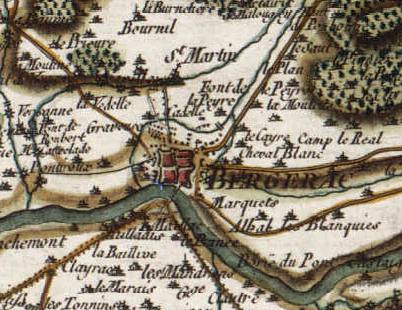Battle of Bergerac
| Battle of Bergerac | |||||||
|---|---|---|---|---|---|---|---|
| Part of Hundred Years War | |||||||
 18th. Century map showing Bergerac within its defences, the bridge and suburbs south of the Dordogne |
|||||||
|
|||||||
| Belligerents | |||||||
|
|
|
||||||
| Commanders and leaders | |||||||
| Henry of Grosmont, Earl of Derby | Henri de Montigny, Seneshal of Périgord | ||||||
| Strength | |||||||
| 1200 men-at-arms (of which 700 were Gascons), 1500 Longbowmen, 2800 Gascon Infantry | 1600 men-at-arms, unknown number of infantry | ||||||
| Casualties and losses | |||||||
| unknown | 600 men-at-arms, unknown numbers of infantry, plus a large number of prisoners | ||||||
The Battle of Bergerac was fought in August 1345. An Anglo-Gascon Army commanded by Henry of Grosmont, Earl of Derby, defeated a French force under Henri de Montigny, Seneschal of Périgord, outside the walls of Bergerac, leading to the loss of the town. Along with the Battle of Auberoche later in the year, it marked in change in military balance of power in the region and was the first of a series of victories which would lead to Henry of Grosmont being called "one of the best warriors in the world" by a contemporary chronicler
Edward III had determined early in 1345 to attack France on three fronts. The Earl of Northampton would lead a small force to Brittany, a slightly larger force would proceed to Gascony under the command of the Earl of Derby and the main force would accompany Edward to France or Flanders. Henry of Grosmont was appointed the King's Lieutenant in Gascony on 13 March 1345 and received a contract to raise a force of 2000 men in England, plus further troops in Gascony itself. While circumstances would dictate that the main army never reached the continent, Derby's force embarked at Southampton at the end of May. Due to bad weather, his fleet was forced to shelter in Falmouth for several weeks en route, finally departing on 23 July and arriving in Bordeaux on 9 August 1345.
Derby had with him 500 men-at-arms, 500 mounted archers and 1000 English and Welsh foot archers. There was already a small English force in the Duchy, commanded by the Earl of Stafford, Seneschal of Gascony, and the somewhat larger forces of the Gascon Lords, perhaps 1000 men-at-arms and 4000 infantry. Derby marched his force to rendezvous with Stafford at the siege of Langdon, where he took command of the combined force. Stafford had to this point pursued a cautious strategy of small scale sieges. Derby's intention was quite different. After a council of war, it was decided to strike at the major town of Bergerac, where there was an important bridge over the Dordogne River. The capture of the town, which had good river supply links to Bordeaux, would provide the Anglo-Gascon army with a forward base to carry the war to the French. It would also force the lifting of the siege of the nearby allied castle of Montcuq and sever communications between French forces north and south of the Dordogne.
...
Wikipedia
